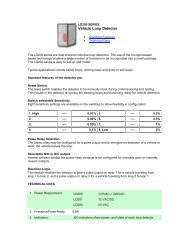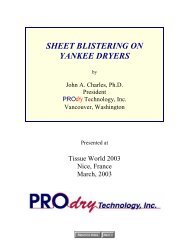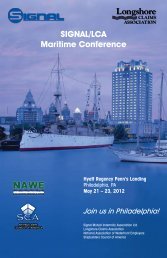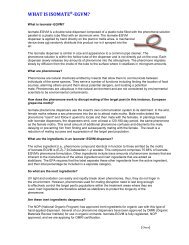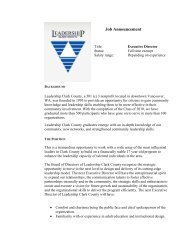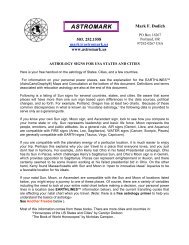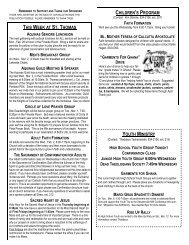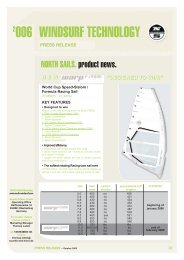Norman Cole's Case Law Review
Norman Cole's Case Law Review
Norman Cole's Case Law Review
Create successful ePaper yourself
Turn your PDF publications into a flip-book with our unique Google optimized e-Paper software.
P.O. Box 9124 Portland, Oregon 97207<br />
NWLAA <strong>Case</strong> <strong>Law</strong> <strong>Review</strong><br />
<strong>Norman</strong> Cole, Editor<br />
Appeals – Issues.<br />
Issue not raised before ALJ not considered on appeal. Stewart v. Dutra Construction Co.,<br />
39 BRBS 54 (1 st Cir 2005), on remand from Supreme Court, 39 BRBS 5 (S.Ct. 2005).<br />
On remand from the Supreme Court, employer argued that even if the dredge was a vessel in<br />
navigation claimant was not a Jones Act seaman. The court refused to consider this<br />
argument due to employer’s failure to raise these legal theories in the prior proceeding.<br />
Appeals – Payments Pending/Stays<br />
Payment not due pending claimant’s appeal seeking reinstatement of order awarding<br />
compensation. Charpentier v. ORTCO Contractors, Inc., 39 BRBS 55 (BRB 2005).<br />
ALJ denied compensation. The Board found compensation was due. The 5 th Circuit held<br />
that Board had applied incorrect legal standard and ordered reinstatement of the ALJ’s<br />
decision denying compensation. Claimant petitioned for writ of certiorari with the Supreme<br />
Court and sought payment of compensation for the period between the date of the Court of<br />
Appeals order and the Supreme Court order denying writ of certiorari. Interpreting §21(c),<br />
which states that “payment of the amounts required by an award shall not be stayed pending<br />
final decision in any such proceeding unless ordered by the court,” the Board held that no<br />
payment was due. The 5 th Circuit’s decision meant that there no longer was any amount<br />
“required by an award.” To require payment would be in conflict with the 5 th Circuit’s plain<br />
and unambiguous mandate conclusively establishing that claimant was not entitled to<br />
benefits.<br />
Attorney Fees - Amount<br />
$300/hr to lead attorney, $275/hr to associate lead attorney, and $225/hr to associate<br />
attorney in complex case when attorneys especially skilled. Baker v. Manson Construction<br />
Co., 39 BRBS 427 (ALJ Etchingham 2005) (John Hillsman for claimant; Richard Wooten for<br />
employer).<br />
Book 4, No. 9<br />
Page 1
NWLAA <strong>Case</strong>law <strong>Review</strong> Through January 2006<br />
Claimant’s attorney sought fees and costs of $127,884.37 before OALJ from 12/9/01<br />
through 3/31/05 (309 hours for lead attorney, 19.5 hours for associate lead attorney, 3 hours<br />
for associate). ALJ held lead counsel in the highest regard, found the case complex, and<br />
considered employer’s counsel’s rate of $250/hour telling, as well as employer’s counsel’s<br />
fees of $228,000, almost double that requested by claimant’s counsel. Claimant recovered<br />
$165,858.00, which was a good result. The ALJ awarded $300/hr to claimant’s lead counsel<br />
and $275 and $225 to other counsel, plus $125/hr for the paralegal. Some hours claimed<br />
were reduced, primarily because the service had more to do with a Jones Act claim than with<br />
a LHWCA claim. Total approved fee was $97,520.50.<br />
$235/hr awarded for most experienced LHWCA attorneys in Southern California. Trejo<br />
v. American Ship Management, 39 BRBS 422 (ALJ Mapes 2005).<br />
ALJ awarded $235/hour to claimant’s attorney as this is the rate usually awarded to the most<br />
experienced LHWCA attorneys in Southern California.<br />
Attorney Fees - Entitlement<br />
Fee denied when overall result unfavorable to claimant. Heinz v. Foss Maritime, 39 BRBS<br />
381 (ALJ Mapes, 2005) (Greg Bunnell for claimant; Russell Metz for employer).<br />
ALJ awarded PTD for greater period of time than defendant had voluntarily paid but at a<br />
lower average weekly wage than paid, resulting in $7,559.66 net overpayment. The ALJ<br />
denied claimant’s request for fees and costs because claimant was not the prevailing party.<br />
Causation - §20 Presumption.<br />
§20 presumption invoked for claimant, not against a particular employer. McAllister v.<br />
Lockheed Shipbuilding, 39 BRBS 35 (BRB 2005); Schuchardt v. Dillingham Ship Repair, 39<br />
BRBS 64 (BRB 2005).<br />
In an occupational disease/death claim, causation is evaluated without reference to a<br />
particular employer. Any employer can rebut the presumption by producing substantial<br />
evidence that the injury was not related to or hasted by employment exposure. If rebutted,<br />
the presumption no longer controls. Once causation is established each employer bears the<br />
burden of proving that it is not the responsible employer either by proving that there was no<br />
exposure to injurious stimuli in quantities that had the potential to cause the disease or that<br />
the employee was exposed to injurious stimuli while working for a subsequent covered<br />
employer.<br />
Book 4, No. 9<br />
Page 2
NWLAA <strong>Case</strong>law <strong>Review</strong> Through January 2006<br />
Death – Amount of Award<br />
Death benefit not capped by worker’s AWW. Weeks v. US Elevator Corporation, 39 BRBS<br />
25 (BRB 2005).<br />
The worker died on 6/15/76, and spouse and children were awarded death benefits. In 2002<br />
employer asserted that benefits, with annual adjustments, now exceeded the worker’s<br />
average weekly wage and therefore should be capped. In Director, OWCP v. Rasmussen, 9<br />
BRBS 954 (S. Ct. 1979), the Supreme Court held that the 1972 amendments, which capped<br />
disability at a percentage of the NAWW, did not apply to death benefits due to omission of<br />
the term “death” benefits from §6(b). §9(e) of the 1984 Act states that in computing death<br />
benefits the total benefits shall not exceed the lesser of the worker’s average weekly wage or<br />
the benefit the worker would have been eligible to receive under §9(b)(1). The Board held<br />
in Donovan v. Newport News Shipbuilding & Dry Dock Co., 31 BRBS 2 (BRB 1997), that<br />
the §9(e) cap was applicable only to the initial calculation of death benefits. Therefore,<br />
benefits under the 1972 Act are not capped by the decedent’s average weekly wage when the<br />
§10(f) adjustments cause the award to exceed the AWW. (They can be capped at 200% of<br />
the NAWW.)<br />
Death – Other.<br />
Declarations of deceased employee admissible to prove working conditions and the harm<br />
elements of a prima facie case. If corroborated, and unrebutted, testimony is sufficient to<br />
establish compensability. McAllister v. Lockheed Shipbuilding, 39 BRBS 35 (BRB 2005).<br />
§23(a) provides that declarations of a deceased employee concerning the injury shall be<br />
received and shall, if corroborated by other evidence, be sufficient to establish the injury.<br />
“Injury” includes the working conditions element as well as the harm element of a prima<br />
facie case. If the declarations are corroborated and unrebutted they are sufficient to establish<br />
compensability.<br />
Employer/Employee - Subcontractors<br />
Subcontractor hired to renovate building was not a subcontractor, per §4(a), of a<br />
company in the shipbuilding and repair business. Boyd v. Hodges & Bryant, 39 BRBS 17<br />
(BRB 2005).<br />
Decent worked for H&B, a plumbing, heating, and air conditioning concern, and claimed<br />
exposure to asbestos while on a H&B job at NNS installing pipe in Ship Shed #4. H&B had<br />
no LHWCA coverage, so NNS was joined as a potentially liable general contractor per<br />
§4(a). The ALJ held that H&B was not a subcontractor of NNS.<br />
A general employer can be secondarily liable when an injured employee is engaged in work<br />
that is a subcontracted fraction of a larger project or that is normally conducted by the<br />
general employer’s own employees rather than by independent contractors. Director,<br />
OWCP v. National Van Lines, 11 BRBS 298 (DC Cir 1979), cert. den. 448 US 907 (1980).<br />
Book 4, No. 9<br />
Page 3
NWLAA <strong>Case</strong>law <strong>Review</strong> Through January 2006<br />
NNS was the owner of Ship Shed #4 and was not under a contractual obligation to renovate<br />
the building. NNS was in the shipbuilding and repair business and not in the building<br />
renovation business, and there was no evidence that NNS employees usually performed this<br />
type of work. NNS contracted out a job to an independent contractor but H&B was not a<br />
subcontractor with the meaning of §4(a).<br />
Estoppel<br />
Employer’s stipulation that worker’s claim was subject to LHWCA did not collaterally<br />
estop employer from arguing in death claim that deceased was Jones Act seaman.<br />
Uzdavines v. Weeks Marine, Inc., 39 BRBS 47 (2d Cir 2004).<br />
Collateral estoppel, a.k.a. issue preclusion, applies when (1) the identical issue was raised in<br />
a prior proceeding; (2) the issue was actually litigated and decided in the prior proceeding;<br />
(3) the party had a full and fair opportunity to litigate the issue; and (4) the resolution of the<br />
issue was necessary to support a valid and final judgment on the merits. Here, when the<br />
worker sought compensation for asbestosis employer stipulated that the claim was subject to<br />
the LHWCA but obtained dismissal based on violation of §33. When the survivor filed a<br />
claim for compensation for death, employer argued that the worker was a Jones Act seaman.<br />
Because the parties did not litigate coverage, and counsel for employer stated that the<br />
stipulation was not binding regarding other claims brought against the employer, employer<br />
was not collaterally estopped from asserting its Jones Act argument in response to the<br />
survivor’s claim.<br />
Exclusions - Clerical<br />
Data processors do not analyze data. This claimant not exclusively engaged in data<br />
processing and not subject to exclusion. Lockheed Martin Corporation v. Morganti, 39<br />
BRBS 37 (2d Cir 2005).<br />
Morganti spent 40% of his time testing equipment used for sonar equipment by the Navy on<br />
the Paganelli, a research barge moored on Cayuga Lake. Employer argued he was excluded<br />
as an employee engaged exclusively in data processing. The court observed that no caselaw<br />
had defined data processing but concluded that data processing did not encompass analysis<br />
of data in the sense of examining the meaning the data or drawing conclusions from the data.<br />
Morganti verified the facial validity of each test he ran by inspecting test results. He<br />
decided if results supported the conclusion that the test had been correctly administered.<br />
This task was analytical, so he was not exclusively employed to perform data processing.<br />
Shipyard field cost clerk and payroll technician lacked status. Excluded as clerical<br />
worker. Fountain v. Northrop Grumman Ship Systems, Inc., 39 BRBS 353 (ALJ 2005).<br />
As field cost clerk in payroll department beginning in 1977 claimant gathered timecards<br />
from each of the shops, passing through the production yard to do so. In 1997 claimant<br />
became a payroll technician and group leader in timekeeping. Employees scanned their<br />
Book 4, No. 9<br />
Page 4
NWLAA <strong>Case</strong>law <strong>Review</strong> Through January 2006<br />
badges to clock in rather than punch a time card. Claimant received daily printouts and went<br />
to the field to obtain corrections from supervisors. This work was excluded as clerical<br />
worker. Trips to shop were incidental to clerical function.<br />
Shipyard senior engineer not exclusively engaged in clerical or data processing work.<br />
Wheeler v. Newport News Shipbuilding & Dry Dock Co., 39 BRBS 49 (BRB 2005).<br />
Claimant’s employment duties as a senior engineering analyst was not exclusively clerical<br />
or data processing. He reviewed specifications for parts to be used in construction or repair<br />
of a vessel to ensure their accuracy and suitability, utilizing various database systems,<br />
computer programs, and if necessary visual inspection of parts. If parts were incorrect he<br />
would meet with engineers to recommend the appropriate part. He had to read and interpret<br />
papers and drawings.<br />
Exclusions – Jones Act<br />
Floating platform with clamshell bucket capable of limited self propulsion was vessel in<br />
navigation. Stewart v. Dutra Construction Co., 39 BRBS 54 (1 st Cir 2005), on remand from<br />
Supreme Court, 39 BRBS 5 (S.Ct. 2005).<br />
Dutra operated a dredge, the Super Scoop, which was a massive floating platform from<br />
which a clamshell bucket was suspended beneath the water. It dumped the sediment on one<br />
of two scows floating alongside. It had a captain and crew, navigation lights, ballast tanks,<br />
and a crew dining area, but it had limited means of self-propulsion. It moved long distances<br />
by tugboat but navigated short distances by manipulating anchors and cables. On the Boston<br />
“Big Dig” project, where claimant was injured, it moved this way once every couple hours,<br />
covering 30-50 feet each time.<br />
Claimant maintained the mechanical systems on the Super Scoop and was injured when on<br />
board Scow #4. He was feeding wires through a hatch when the scow collided with the<br />
Super Scoop, causing claimant to plunge through the hatch to the desk below. Claimant<br />
filed suit against Dutra under the Jones Act and a §5(b) suit against the “vessel” owner for<br />
negligence.<br />
On remand from the Supreme Court, the court held that claimant was a Jones Act seaman.<br />
No factual dispute remained regarding whether the Super Scoop was a vessel capable of<br />
maritime transport.<br />
Oiler on dredge was Jones Act seaman. Uzdavines v. Weeks Marine, Inc., 39 BRBS 47 (2d<br />
Cir 2004).<br />
Decedent worked on a bucket dredge – a large barge with a crane that scooped silt and<br />
placed it in the barge. It had a limited capacity to move itself with steel spuds. Claimant<br />
worked for 3-4 consecutive weeks as an oiler making sure that everything was running<br />
properly while the dredge was in the middle of the water and gradually moving across the<br />
Book 4, No. 9<br />
Page 5
NWLAA <strong>Case</strong>law <strong>Review</strong> Through January 2006<br />
channel. His claim for asbestosis was dismissed due to a §33 violation, but after his death<br />
his survivor sought compensation.<br />
Based on Stewart v. Dutra Construction Co., 125 S. Ct. 1118 (2005), claimant conceded that<br />
the dredge was a vessel. The court held that it was in navigation (used, or capable of being<br />
used, as a means of transportation on water) because it was actively used to deepen<br />
navigation channels and could not have performed this task without the ability to transport<br />
equipment and workers across navigable waters. The deceased had a substantial connection<br />
to the vessel, without any consideration of his prior work history, that was substantial in<br />
terms of duration and nature and was not merely transitory or sporadic. Therefore the<br />
decedent was a Jones Act seaman and exempt from coverage under the LHWCA.<br />
Cleaning barge held in place by spuds was vessel in navigation. Bunch v. Canton Marine<br />
Towing Co., Inc. 39 BRBS 59 (8 th Cir 2005).<br />
Claimant spent 90% of his work time on a cleaning barge moored to the bed of the Missouri<br />
River with spud poles. The barge contained water pumps, vacuum tanks, cleaning tools, a<br />
generator, a CB radio, and a satellite. It was moved once from the Illinois side of the river<br />
to the Missouri side during claimant’s employment. Claimant was ferried daily to and from<br />
the barge aboard the Sir Joseph. He spent 10% of his time working as a deck hand on the<br />
Sir Joseph. Claimant was injured climbing aboard the Sir Joseph one day.<br />
The court held that the cleaning barge was a vessel and thus in navigation. It was not<br />
permanently moored or anchored and it had been moved during the time claimant was<br />
employed. It was built for use in navigation and was moored in the river rather than to the<br />
shore. It floated. It may be near the outer limits of what the court would recognize as a<br />
vessel, but a vessel is not defined by its capability for self propulsion. As no other facts<br />
were disputed, claimant was found to be a Jones Act seaman.<br />
Work on derrick barge was work as Jones Act seaman; assisted with movement of vessel.<br />
Elliott v. Connolly Pacific Co., 39 BRBS 400 (ALJ Mapes 2005).<br />
Claimant spent 75-80% of his time on three derrick barges used to unload rocks from a<br />
freight barge and use rocks to construct outer perimeter of a pier. Also working on the<br />
barges were four other workers: barge foreman, crane operator, oiler, and deck engineer.<br />
The barges moved by a process called fleeting in which the barges would slack off some<br />
anchor lines and tighten other anchor lines.<br />
Claimant’s work contributed to the mission of the barges. His connection to the vessel was<br />
substantial and certainly in excess of a 30% rule of thumb applied in other cases. A<br />
construction worker who works on barge that is anchored or secured to a pier and is on the<br />
barge when it moves is not a seaman but a worker who works on board construction barges<br />
during periods when they are being moved and assists in such movement can be a Jones Act<br />
seaman, as here, where claimant was on board when the vessel was moved and was exposed<br />
to hazards of the sea. His job was more consistent with deckhand.<br />
Book 4, No. 9<br />
Page 6
NWLAA <strong>Case</strong>law <strong>Review</strong> Through January 2006<br />
Exclusions - Other<br />
Souvenir photographer on battleship Missouri lacked status as employee of retail outlet.<br />
Peru v. Sharpshooter Spectrum Venture, LLC, 39 BRBS 43 (BRB 2005).<br />
The Battleship Missouri Memorial operates the museum vessel Missouri in Pearl Harbor and<br />
subleased employer a part of the premises to use for photography production and concession<br />
site. Claimant took pictures of tourists on the vessel and offered them for sale from a booth<br />
on the pier as tourists disembarked. He banged his head on a ladder on the vessel.<br />
Claimant was an employee of a retail outlet and therefore excluded from coverage. An<br />
outlet need not be a store in the traditional sense of having four walls and a front door. The<br />
sale of phonographs is a retail function and sufficient to come within the exclusion.<br />
Furthermore claimant’s duties did not involve maritime activities.<br />
Hearings - Evidence<br />
Hearsay admitted. McAllister v. Lockheed Shipbuilding, 39 BRBS 35 (BRB 2005).<br />
A transcript of a third party’s testimony in a prior unrelated claim that asbestos was present<br />
at employer’s shipyard was admissible but was not alone sufficient to prove that the<br />
decedent was exposed to that asbestos.<br />
Attorney representation at hearing is not evidence. Lynch v. Newport News Shipbuilding &<br />
Dry Dock Co., 39 BRBS 29 (BRB 2005).<br />
The ALJ accepted claimant’s counsel’s representation that Dr. Stiles treated spines and<br />
concluded that claimant was entitled to treat with Dr. Stiles. On appeal, the Board held that<br />
the ALJ could not rely on an attorney’s representation to reach this decision.<br />
Insurance - Coverage<br />
Carrier burden to prove it did not provide coverage. Belcher v. Richmond Steel Company,<br />
39 BRBS 235 (ALJ 2005).<br />
Insurance ledger cards from the Virginia Workers Compensation indicated the carrier<br />
provided coverage starting in 1958. The carrier submitted a policy that indicated workers’<br />
compensation coverage, including LHWCA coverage, from 1/1/62 to 1/1/63. Claimant<br />
ended his employment for the employer in 1961 but testified that he saw claim forms with<br />
the carrier’s name on it during his employment. The court held that the carrier had the<br />
burden to show the inapplicability of an insurance policy because the relevant documents<br />
could only be within the carrier’s exclusive control. Carrier failed to meet its burden and<br />
was found responsible.<br />
Book 4, No. 9<br />
Page 7
NWLAA <strong>Case</strong>law <strong>Review</strong> Through January 2006<br />
Medical Services – Other.<br />
ALJ has authority to decide factual disputes including whether physician is qualified to<br />
treat claimant. District Director can determine necessity, character, and sufficiency of<br />
treatment. Lynch v. Newport News Shipbuilding & Dry Dock Co., 39 BRBS 29 (BRB 2005).<br />
After the treating orthopedist retired claimant selected orthopedist Dr. Stiles. Employer<br />
objected, contending that claimant should select a spine specialist. After an informal<br />
conference the claims examiner agreed that claimant should select a spine specialist and<br />
directed claimant to see Dr. Carlson. On appeal, the Board held that the ALJ had<br />
jurisdiction over factual disputes, including whether claimant requested authorization,<br />
whether employer refused, whether treatment was reasonable and necessary, whether the<br />
physician’s report was filed timely, and whether Dr. Stiles was qualified to treat claimant.<br />
The Board remanded the case to the district director to determine the necessity, character,<br />
and sufficiency of any treatment to be provided by Dr. Stiles and determine if treatment by<br />
another physician is desirable or necessary in the interest of the employee.<br />
Responsibility – Hearing Loss Claims<br />
First audiogram not determinative. Second audiogram determinative, so second and last<br />
employer responsible. Universal Maritime Services v. Perry, 39 BRBS 33 (4 th Cir 2005).<br />
On 10/26/00, when employed by Ceres, claimant had a baseline audiogram at the end of the<br />
work day, after exposure to usual loud noise at work. The test was administered by a<br />
technician. On 10/30/00 he began working for Universal. On 12/26/00 he had a second<br />
audiogram, but this test was performed after he had not worked for five days and was<br />
administered by an audiologist. Experts testified that the audiograms were contradictory and<br />
both could not be accurate. The ALJ found the second audiogram determinative and<br />
therefore found Universal responsible. BRB and Court affirmed.<br />
Settlements<br />
Settlement not set aside. Unrepresented claimant did not lack capacity to understand.<br />
Spatcher v. Jacksonville Shipyards, 39 BRBS 229 (ALJ 2005).<br />
Claimant asked the ALJ to set aside a settlement for a small amount of monaural hearing<br />
loss because he was illiterate, had an IQ of 50, was mentally retarded, and claimed he did<br />
not understand nature of the settlement which he signed when not represented by counsel.<br />
There was no evidence interpreting the IQ scores in relation to his ability to understand<br />
matters. Experienced counsel initially negotiated the settlement. The OWCP approved the<br />
settlement as adequate. Claimant failed to establish he lacked mental capacity to understand<br />
or comprehend the settlement agreement.<br />
Book 4, No. 9<br />
Page 8
NWLAA <strong>Case</strong>law <strong>Review</strong> Through January 2006<br />
Status – Integral Employment<br />
Work renovating building was not maritime in nature. Lacks status. Boyd v. Hodges &<br />
Bryant, 39 BRBS 17 (BRB 2005).<br />
Decedent worked for H&B, a plumbing, heating, and air conditioning concern and claimed<br />
exposure to asbestos while on a H&B job at NNS installing pipe in Ship Shed #4. At the<br />
time of employment Ship Shed #4 had been gutted and was undergoing total renovation and<br />
was not in use for shipbuilding. Decedent’s work involved plumbing, heating, and air<br />
conditioning which was not inherently maritime employment. His failure to perform the job<br />
would not eventually impede the shipbuilding process. His presence on the premises was<br />
temporary.<br />
Welder injured during training and certification school who lacked certification lacked<br />
status. Taylor v. Newport News Shipbuilding & Dry Dock Co., 39 BRBS 22 (BRB 2005).<br />
Claimant was hired as a welder at employer’s shipyard but had to be certified before he<br />
could work on any Navy contracts. Therefore, employer ran a training and certification<br />
school for all employees. He was injured when in training.<br />
Claimant’s duties as welder trainee are not covered. They were not essential or integral to<br />
shipbuilding. The projects worked on by trainees were not used in construction or repair of<br />
ships. There was no guarantee he would ever work on a ship, since he had to receive his<br />
certification first.<br />
Shipyard field cost clerk and payroll technician lacked status. Duties not integral to<br />
shipbuilding. Fountain v. Northrop Grumman Ship Systems, Inc., 39 BRBS 353 (ALJ 2005).<br />
As field cost clerk in the payroll department beginning in 1977 claimant gathered timecards<br />
from each of the shops, passing through the production yard to do so. In 1997 claimant<br />
became a payroll technician and group leader in timekeeping. Employees scanned their<br />
badges to clock in rather than punch a time card. Claimant received daily printouts and went<br />
to the field to obtain corrections from supervisors. This work was not integral to loading,<br />
unloading, constructing or repairing a vessel. Trips to shop were incidental to clerical<br />
function.<br />
Union agent lacked status. Warren v. Lockheed Shipbuilding, 39 BRBS 444 (ALJ<br />
Etchingham 2005) (Charles Robinowitz for claimant; Russell Metz for employer/carrier).<br />
Claimant’s work history included work as a manager of Local 541, Seattle Ship Scalers<br />
union, which merged with Laborer’s Local 252, and as business agent for the local. He<br />
helped enforce the collective bargaining agreements with the various shipyards by handling<br />
complaints and grievances that employees brought to him. His office was 3-7 miles from<br />
the shipyard. He spent 50-70% of his time in the office and otherwise spent time at<br />
shipyards investigating complaints and resolving disputes or socialized with workers.<br />
Book 4, No. 9<br />
Page 9
NWLAA <strong>Case</strong>law <strong>Review</strong> Through January 2006<br />
The ALJ held that this employment lacked status. He had no authority to interrupt work and<br />
was not an integral or essential part of unloading or loading a vessel.<br />
Status – Navigable Waters<br />
Status due to injury on navigable waters on shuttle boat ride from barge to shore.<br />
Lockheed Martin Corporation v. Morganti, 39 BRBS 37 (2d Cir 2005).<br />
Morganti spent 40% of his time testing equipment used for sonar equipment by the Navy on<br />
the Paganelli, a research barge moored on Cayuga Lake. He had a fatal accident on a shuttle<br />
boat returning him to shore from the Paganelli. The Paganelli had been moored to buoys<br />
since 1982, but the Paganelli could be disconnected from the buoys within minutes. Cayuga<br />
Lake is connected to the Erie Canal system which means that a boat could sail to any ocean<br />
connected port in the world.<br />
Cayuga Lake is a navigable waterway because it is used or is susceptible of being used as a<br />
highway for commerce. Because the lake is physically capable of supporting shipping it is<br />
possible at any time for an interstate commercial vessel to enter the lake.<br />
Morganti’s time on the Paganelli was time on navigable waters, rather than time on a fixed<br />
platform. Therefore, the court declined to consider application of the transient and<br />
fortuitous exception.<br />
NWLAA <strong>Case</strong> <strong>Law</strong> <strong>Review</strong> is published and distributed to NWLAA members for<br />
educational purposes only. The information and the opinions expressed herein should<br />
not be acted upon without legal advice. All rights are reserved. No part of the<br />
NWLAA <strong>Case</strong> <strong>Law</strong> <strong>Review</strong> may be reproduced without the written consent of the<br />
NWLAA and its officers.<br />
The NWLAA <strong>Case</strong> <strong>Law</strong> <strong>Review</strong> is provided by <strong>Norman</strong> Cole. Mr. Cole previously<br />
worked as trial counsel for SAIF Corporation for 26 years. As of May 23, 2005 he is at<br />
the Portland, Oregon firm of Sather, Byerly & Holloway, where he continues to<br />
represent employers and carriers in workers’ compensation claims under the Oregon<br />
Compensation Act and the L&HWCA.<br />
<strong>Norman</strong> Cole<br />
Direct Dial: 503-595-2131<br />
E-Mail: ncole@sbhlegal.com<br />
Book 4, No. 9<br />
Page 10




